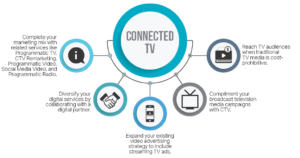Connected TV, known as CTV, is one of the fastest growing major ad channels in the United States, giving marketers some of the best targeting opportunities—in fact, the industry is projected to reach a massive $30.10 billion in ad spend by 2024.
It’s a good idea for programmatic marketers to get to grips with CTV and look into the opportunities to include it within a digital strategy. But you might not understand exactly what it is. Here, we’ll go through what CTV advertising is and what it means for your strategy.
What is Connected TV?
A connected TV is also known as a smart TV, that’s connected to the internet. Because of this, advertisers are able to utilize the TV space to show interactive ads, in-stream ads, video ads, or online video (OLV) ads.
As CTVs are growing in popularity, so is the audience of CTV ads. According to recent statistics, there are 110,000,000 Millennial and Gen Z viewers of CTV—which will only grow as the population increases. In fact, CTV is quickly becoming the standard TV type available on the market, as it’s been estimated that 86.3 million US households will be CTV viewers by 2025—which surpasses the number of households using traditional TV.
What is Connected TV Advertising?
Now we know what CTV is, we can delve into what CTV advertising is. Connected TV advertising refers to any advert that’s delivered via the smart TV, whether this is through sidebar adverts or while streaming any video content. This could either be through the TV itself, or via a connected device, such as Amazon Fire Stick or Roku.

CTV ads or OTT ads?
CTV and OTT (over-the-top) are sometimes used interchangeably, but they are not the same thing. CTV ads refer only to viewing that occurs on the connected TV, while OTT refers to all views of the ads, including on mobile devices, tablets, and personal computers.
While all CTV ads are considered OTT ads, not all OTT ads can be CTV ads.
Benefits of CTV Advertising
As previously mentioned, smart TVs are growing in popularity and will soon become the norm across US households. However, investing in CTV advertising also provides some immediate benefits for your business.

Targeted reach
The very nature of CTV advertising means you can segment your audiences based on different variables, including viewing behavior, location, time zones and interests. This is much more targeted than a traditional TV advert, which is simply viewed by whoever happens to be watching the channel at that time.
And while you do have some control over when and where you advert is played (such as paying a premium price to appear during a popular time or alongside popular shows), CTV advertising allows you to be much more selective.
Higher engagement rates
Viewers of CTV content have actively searched for the content to consume, which means they’ll likely be much more receptive to the ads than the average Joe. In fact, research has found that engagement with CTV content leads to a 95% video completion rate.
By carefully choosing where you want your ads to appear, you’ll be able to target them to a highly relevant audience which (should) result in a higher conversion rate.
Improved measurement
While every aspect of digital marketing requires measuring KPIs and other data analysis, CTV provides insight into events, such as:
- Views
- Impressions
- Clicks
- QR code scans
- Attention paid
With CTV advertising, you can view your metrics in real time, allowing you to make any adjustments to your campaign as necessary—whether that be times you want the ad to appear, or the demographic you want to target.
Granular control
Unlike traditional OOT advertising, CTV provides an extra level of control. You’re able to choose exactly which platform you want your ad to appear, making sure that you’re targeting exactly the right audience that’s more likely to convert.
For example, if you’re promoting toys for children up to the age of 11, you’d ideally want your advert to appear during the most popular television shows for this age group.
You’re also able to add elements such as a click-through link or even a QR code to be scanned by the viewer’s smartphone, so they’re able to browse your website while continuing to watch their chosen show or movie.
Detailed audience insights
As discussed, with CTV ad campaigns, you’re able to make any adjustments in real time, as necessary. This is due to the level of detail that’s provided by the data and analytics—especially when compared to the traditional TV ads, where a lot of guesswork is required based on generalizations and assumptions about specific channel audiences.
Thanks to the smart TV capabilities, you’re able to track exactly who your viewing demographic is, based on location, interests, viewing history, behavior, devices and even any patterns in their viewing history.
Cost-effective advertising
Because CTV adverts allow you to be as accurate as possible—and only appear when your chosen demographic is online—you’re able to better control your ad budget. It allows you to get the biggest ROI, by targeting the exact audience you want to convert, rather than casting a wide net as with traditional television advertising.
Being able to target a very specific demographic allows you to optimize your ad spend, giving you a much more efficient budget.
How Programmatic CTV Ads Work
Now you know all about what CTV ads are and the benefits they provide, it’s time to look into how they actually work and how to get started. Programmatic CTV ads simply automate the process of buying your ad space through the use of a demand-side platform (DSP).
Taking a programmatic approach to buying CTV ads allows you to easily scale your output, through purchasing ads by impressions, as opposed to bulk buying ad space, like in traditional TV ads.
Buying ad impressions also means you’re able to switch between platforms, rather than commit to a single television network, which can be a large upfront cost, without the guarantee of your ad being seen by the audience you want it in front of.
Programmatic CTV ads also means you’re able to utilize cross-device global frequency capping. This means you can set how many times your ad is seen by a specific person or household, across all digital channels, by setting the right parameters. Doing this reduces ad fatigue and avoids your audience being put off by repetitive adverts while streaming. It also means you’re able to efficiently allocate your budget on targeting new audiences.
Choosing Grapeseed as your CTV Partner
Targeting the right audience for your CTV ads can be confusing—especially when considering the sheer size of a global market. However, we’re experts in programmatic and DSPs.
Our approach to programmatic CTV ads is agnostic. We’re not partners with a specific DSP and are on hand to help you find the one that’s best suited to your business needs—whether you want to target a specific geographic audience or you’re looking to grow your audience on a budget.
Get in touch with our team of experts, and we’ll help you plan your next CTV ad.

